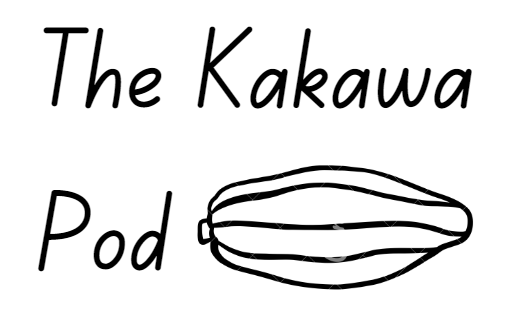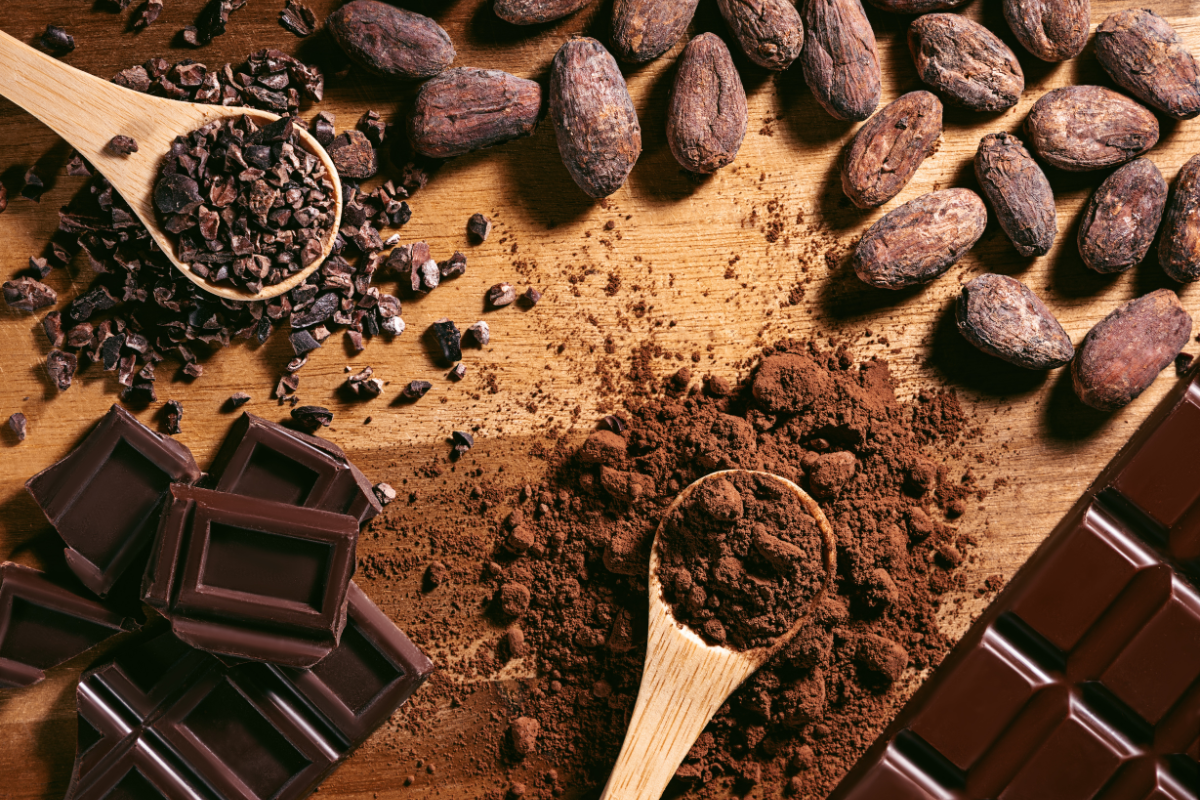The difference between cocoa and cacao is somewhat confusing, but I’ll help you understand it better.
The two words are often used interchangeably, but generally speaking, ‘cacao’ is used more to refer to a lesser-processed product of the Theobroma cacao tree whereas ‘cocoa’ refers to a more processed product.
This is why you’ll often see ‘cacao’ more heavily advertised in health stores. People are looking for that less-processed, more raw product.
In this post, I’ll be going over the trickiness of these two words being used interchangeably for marketing purposes (watch out!), how these two words came to mean what they mean today with a little history lesson, processing differences, and nutritional differences.
But first, let’s talk about what these words mean directly, and then we’ll get into the products they refer to.
Cocoa = cacao in Spanish
A quick Google translate will show that ‘cocoa’ in English simply translates to ‘cacao’ in Spanish..

So does this mean they are simply the same thing in different languages?
Well, not really.
As mentioned, ‘cacao’ is used more to refer to products that come from Theobroma cacao that are on the lesser processed side of the spectrum, whereas your overly-processed Hershey’s chocolate is going to say ‘cocoa’… most of the time.
Cocoa is the English version. Or I guess I should say it was the English version, although today you see ‘cacao’ advertised more and more due to the perceived rawness of the product.
There seems to be no universally agreed-upon definition of the two, but let’s take a look at what the dictionary says.
What the dictionary tells us
The English language authority Cambridge states in their dictionary that ‘cocao‘ is:
a dark brown powder made from cocoa beans, used to make chocolate and add a chocolate flavor to food and drink
And for ‘cacao‘ they state:
the seeds of a tropical tree, from which chocolate and cocoa are made
According to the Oxford Dictionary, ‘cocoa’ is a powder which is made from the beans, which requires processing, whereas ‘cacao’ simply refers to the seeds of the Theobroma cacao tree itself… of which cocoa is made.
This is saying that ‘cacao’ only refers to the raw seeds. But most people don’t agree with this.
According to WebMD:
Cacao is the raw, unprocessed version of cocoa.
But what does ‘unprocessed’ mean? I think most people would agree with ‘lesser’-processed, as we’ll go over.
And, from a Reddit post:
The basic difference – Cacao is unroasted (raw), cocoa is roasted
So according to this discussion, cacao just means the beans are unroasted. But does this mean that they have already gone through the fermentation process?
Where things get even more confusing
Let’s take a look at some Hershey’s products. Whether you like their mostly overly-sweetened chocolate products or not is besides the point. The fact is that they are an authority in the space and have a big impact on what people might think when they hear ‘cocoa’ vs ‘cacao’. After all, in 2023 they had a 45% share of the American chocolate market.
This will probably just make us more confused now, but by the end you’ll have a better understanding of the real difference between cocoa and cacao.
If we take a look at some Hershey’s Cocoa powder sold in Walmart in the US we can see that they state that it has “100% cacao”…
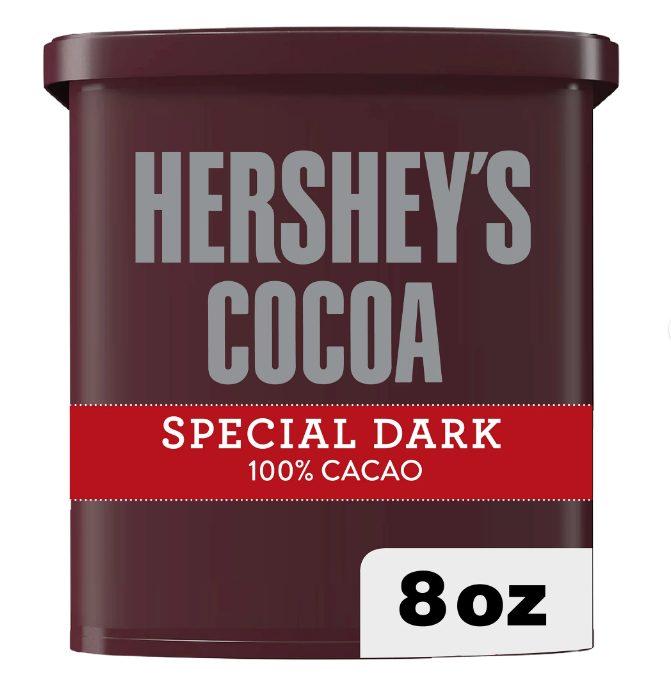
Yes, and what you can’t see from the image I’ve put above is that this particular product of Hershey’s is their ‘Dutched’ cocoa version, which means that it’s been processed with alkali to help remove some of the bitter taste.
In other words, this is some of the most processed cocoa you’ll find on the market, yet they are marketing it as being “100% cacao”.
Now, to give them credit, they did state in the Ingredient section that it is made up of “cocoa processed with alkali”, but many people aren’t even going to look here once they see that big “100% cacao” label on the front.
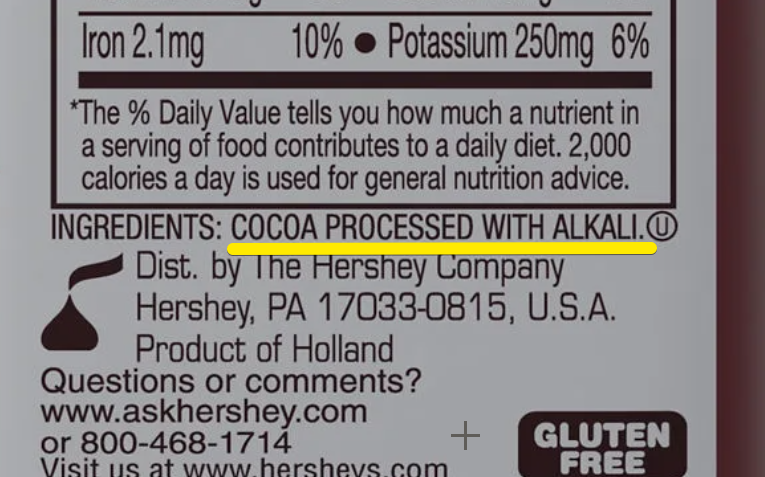
What to make of all of this?
I’ll tell you what I think is going on here and how this blurry difference between cocoa and cacao came to be.
I’ll have to go over some history to explain it.
You see, cacao had been drunk in the Americas for thousands of years by the time the Spanish came and eventually brought the drink to Europe in the 1500s. The processing would have been artisanal and minimal. For example, in what is now the Mexico area, the Mayas and Aztecs used a hand-grinding stone called a metate to smash and grind the toasted beans.
When it arrived in the European market it encountered new tongues and new technologies. And, it didn’t have the sacredness that it had once had with the Mayas, Aztecs, etc. in the Americas.
So, with nothing stopping them and the quest for making the most palatable chocolate possible being the goal, the Europeans changed much of the way chocolate was consumed.
Some inventions that would change the way chocolate is consumed include:
- hydraulic cocoa press invented in Amsterdam in 1828 by a Dutch chemist – used to extract the cocoa butter
- dutching process invented to make less acidic chocolate (also in 1828)
- mechanical process of ‘conching’ invented in 1870 to produce finer chocolate
- milk powder added to chocolate in 1875 by a Swiss chocolatier
The Swiss mastered milk chocolate. In Belgium there fine chocolate bonbons were a focus and are considered by many to still be the best in the world. The Italians mixed in hazelnuts to make a cream which would eventually lead to the popular Nutella. In France, they stuck a bit more to the original recipe of a darker hot chocolate drink.
In English-speaking countries like the US and UK, chocolate was highly processed compared to the original versions consumed by people such as the Mayas.
In 1847, the British company J. S. Fry & Sons, Ltd, better known as Fry’s, started to mass produce what is considered to be the first [modern] chocolate bar.
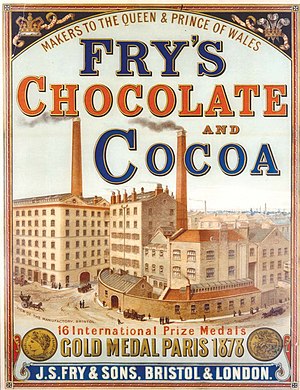
And as you can see, they were advertising it as ‘cocoa’.
I haven’t been able to find much information on the ingredients of these bars, but I have found that they were comprised of cacoa powder, cocoa butter, and sugar.. and that the cocoa concentration is believed to have been only around 30-40%.
The company, with Joseph Fry running things, worked at perfecting the texture and taste of the chocolate by removing excess cocoa butter and then added it back in to get the right blend, a process that is still used a lot today… and definitely requires a good amount of ‘processing’.
The company also sold other products like “Fry’s Pure Concentrated Cocoa”, for which Joseph Fry’s 1795 patented steam engine machine to grind the beans would have been used.
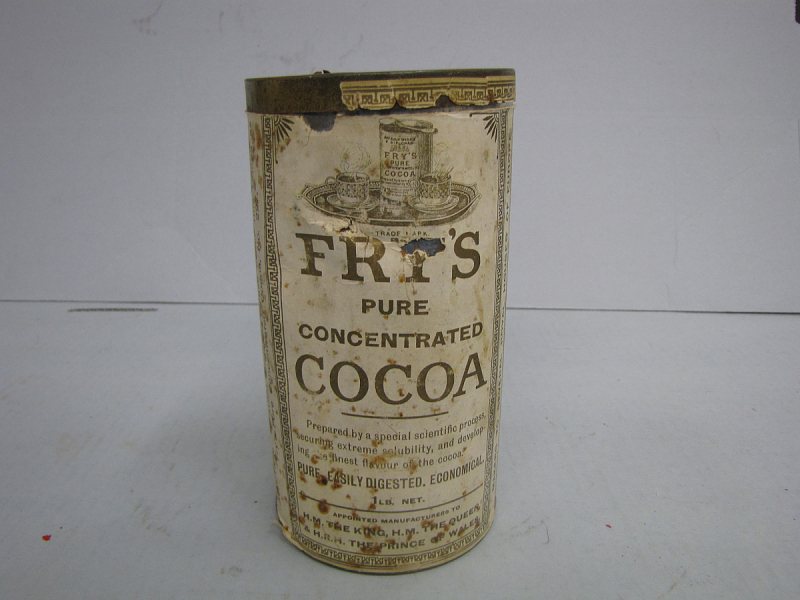
Big mechanical machines. Lots of heating, removing, adding back to it.
All of these processes and the final products often being called ‘cocoa’.
This is how I think ‘cocoa’ came to mean the more processed version of ‘cacao’. It may have started out as a simple difference in languages, but due to the overly processed variations being sold as ‘cocoa’ in English-speaking countries, this connotation has stuck to it.
‘Cocoa’ turning back into ‘cacao’..?
Cocoa was cocoa… but what’s going on with large companies like Hershey’s now labeling their products with ‘cacao’?
This has nothing to do with changes in their products.
It has everything to do with marketing.
Current health trends are favoring less-processed foods. People are more health conscious than they once were and Hershey’s is trying to capitalize on this with the ‘cacao’ labeling.
However, don’t be fooled. Whatever you want to call their powder that is made from the bean of the Theobroma cacao tree doesn’t matter. What does matter is the fact that it is processed to a very high degree.
Processing Differences: From Bean to Product
I´ve already mentioned a few of the different processes that cocoa/cacao goes through before it ends up in your mouth, but let’s talk about some of these in greater detail.
Let’s start off by going over the processes that both ‘cocoa’ and ‘cacao’ share. Then, ‘cacao’ will be left in a lesser-processed state whereas what we call ‘cocoa’ will go through some more processing.
Cocoa and cacao processing:
Even the rawest cacao you can find on the market is still ‘processed’ to some extent. It has to be.
After the cacao pod is picked from the tree, the fermentation ‘process’ begins. Yes, it’s a natural process that would happen inside the cacao pod regardless, but we humans like to take control of things to our benefit and so even the rawest cacao is likely the result of the seeds being removed and then fermented both anaerobically and aerobically for anywhere from 3-12 days.
This fermentation is made possible due to the sweet (contains sugar) pulp that surrounds the cacao seeds (beans… same thing).
*Note: In Mexico, there's something you'll find at some of the OG chocolaterias that's called cacao 'lavado', which literally means 'washed' cacao. This type of cacao is immediately washed to remove the pulp after harvesting and then dried, not giving it a chance to ferment.
This said, 99+% of the chocolate in the world has been fermented, which changes the flavor profile a bit, such as by reducing bitterness.
After done with the fermentation, the cacao is set out in the sun to dry.
Then it’s roasted, baked, or toasted.
You can purchase whole-bean cacao at this point, or you can find cacao nibs, which have gone through a further process of grinding.
If you’re looking for cacao powder, there’s a good chance this has been ground like the nibs, but just more finely.
*Note: Not all chocolate makers follow the same process. Lindt, for example, roasts their beans after they've already been ground into nibs. This is done to help create a more uniform roasting since the pieces are then much smaller.
Although we saw Hershey’s stating that their extremely processed product has ‘100% cacao’, I think at this point many would agree that this is the end of the line for the processing of ‘cacao’. Anything more and let’s just call it ‘cocoa’.
Many people consider the change from ‘cacao’ to ‘cocoa’ to be at the point when the fat is removed. Even that definition from the Oxford Dictionary that I showed at the beginning defines cocoa as a ‘powder’.
Cocoa gets processed further:
Cocoa powder is dry and powdery because of the removal of the fat from the bean. This is accomplished through brute force with the use of hydraulic presses, the first being invented in Amsterdam in 1828 by a Dutch chemist.
However, just because something is labeled ‘powder’ doesn’t necessarily mean it’s ‘cocoa’ and that the fat has been removed. I have seen many ‘cacao’ powders during my stay in Mexico that still have the fat. They are not so dry and are clumpy because of it. However, they are rare to find in most parts of the world.
After the fat is removed, which is the case for 99%+ of cocoa powders out there, it may then go through the ‘dutching’ process, which is when an alkaline solution (lye) is used to wash it in order to lower the acidity.
Then, if the final product is to be a chocolate bar, the fat is added back to the cocoa powder to get the right mixture for a bar that snaps when broken yet melts easily in the mouth. Due to there being 6 different types of fats in cacao with different melting points, different amounts of these fats can be added back in to get the desired consistency (Casa Cacao, 2018).
We also have what’s called the ‘conching‘ process which is basically just when the chocolate – the combination of the cocoa powder, cocoa butter, sugar, etc. – is blended as finely as possible over an extended period of time… a process that was discovered by the Swiss Rudolph Lindt after accidentally leaving one of his machines running overnight. This process not only helps with the soft texture but also changes the flavor. This process can heat the chocolate to around 160 degrees Fahrenheit due to the friction of the wheels being used to create the finest blend possible (Casa Cacao, 2018).
Not all ‘cocoa’ goes through all of these processes. Of course, this depends on the company and the final product. But, a lot of it does.
For example, if a chocolate bar is being produced then all of the above processes may be employed. However, if it’s a cocoa powder that’s in the making, the cocoa butter would be removed and after that it wouldn’t be mixed back with the powder.
Nutritional Differences
Chances are you’ve heard that ‘cacao’, the less processed version, is more nutritious than its highly-processed brother, ‘cocoa’. But how true is this?
Well, let’s start out looking at some nutrition labels and then dig deeper.
What you see on the left is from organic cacao nibs and on the right we have our common ultra-processed supermarket cocoa powder


First off, we can’t compare these numbers directly because the serving size for each is different. What I think makes more sense is to compare the numbers when the serving size (amount of grams) is the same.
For the nibs, the serving size is 3 grams and for the cocoa powder it’s 5 grams. What I’m going to do is convert the numbers for the cocoa powder to reflect a 3 gram serving size. This way, we’re comparing 3 grams of each.
Here’s what this looks like..
A 3g serving of cacao vs cocoa will give you:
Organic Cacao Nibs
- 19 calories
- 1.4g fat
- 1 carb
- 0g protein
- 23mg potassium
- 9mg magnesium
- 0mg iron
Ultra-processed Cocoa Powder
- 6 calories
- 0.3g fat
- 1.8g carb
- 0.6g protein
- 150mg potassium
- N/A magnesium
- 1.26mg iron
Looking at this list you may be thinking, well the cocoa powder looks more nutritious. After all, it has less fat, more protein, and more potassium per 3 gram serving. And this makes perfect sense. After all, cocoa powders have the fat removed with the use of hydraulic presses, remember? So much of this weight would be removed from the cocoa powder and what you’d have is something more concentrated with some of the nutrients.
However, don’t go out and buy some Hershey’s cocoa just yet. There’s more to nutrition than just the label of what is required to be shown.
One of the big health benefits to cacao/cocoa/chocolate are the antioxidants, of which it has significantly more of than green tea. Its polyphenols are powerful antioxidants that can help reduce inflammation, improve heart health, and a myriad of other things.
However, not all chocolates and cacao/cocoa products are created equal. Some of that processing can destroy these antioxidants.
That Hershey’s cocoa powder nutrition label above is from their ‘Special Dark’ product. This one in particular is very heavily processed. It is dutched cocoa, which means it was was put through the process of being washed with an alkaline solution, causing the pH to increase and lowering the acidity.
This dutching is what makes it that ‘special dark’ color, along with Oreos, and gives it a unique flavor, but I’ve read that this process destroys around 80–90% of the nutrients.
How true is this?
Well, another study that looked at the polyphenols epicatechin and catechin content when cocoa is dutch processed showed significant losses as a result – up to a 98% loss of epicatechin and up to a 80% loss of catechin.
While it looks, smells, and tastes good… it isn’t as healthy in this regard.
The roasting process can also have an effect on the antioxidant content.
Usually, raw cacao beans have higher levels of polyphenols than beans that have gone through some of the processes. This said, roasting the beans the right way can be beneficial.
A 2014 study that tested the effect of roasting on the beans’ polyphenol content showed that at certain temperatures this process of heating the beans can actually lead to increases. During this study, the roasting temperatures were 110, 130 and 150 degrees C and it was the hottest, the 150 degrees C, which led to increases in polyphenol content.
Similar results have been found in other studies.
Besides temperatures, the roasting method also has an impact. For example, roasting with hot steam has been shown to have a lesser impact on polyphenol content than your traditional roasting.
Key takeaways
- Cacao = cocoa in Spanish.
- ‘Cacao’ is generally used in English to refer to less-processed products of the Theobroma cacao seeds.
- ‘Cocoa’ generally refers to the more processed product – subjected to hydraulic presses, additional heating, and even the alkalyzing ‘dutching’ process – likely due to the overly-processed products that were sold in English-speaking countries and under the English name of ‘cocoa’.
- Hershey’s labels their ultra-processed ‘Special Dark’ product as having 100% cacao – a marketing tactic due to the healthier connotation of ‘cacao’.
- Cocoa powder, due to having the fat removed, is more nutrient-dense in some ways if you look at the label, but likely doesn’t have the same antioxidant levels due to the processing.
While cacao is generally referring to the lesser processed product, you can’t be too sure as we’ve seen with the ‘Special Dark’ Hershey’s product. Both words are used rather interchangeably at times and so it’s important that you do your homework.
If you are looking for a more raw, less-processed chocolate then you may need to look further than just the front label.
I hope this post has been helpful. Let me know what you prefer down below! Cacao or cocoa?
